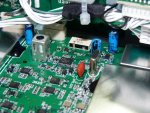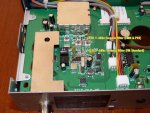Boatanchor
Member
- Joined
- Jul 17, 2011
- Messages
- 991
One thing I would like to point out in defense of the x36HP scanners, is the adoption of true +-4.5Khz (9Khz wide) NFM IF filters. Such a filter has never been included in a Uniden scanner before to my knowledge, despite 'NFM' being available in previous models for many years.
Thanks to N9JIG (http://forums.radioreference.com/members/n9jig.html), we have some nice close up photos of the interior of the 536HP, showing both the 450E (FM) and 450G (NFM) 450Khz ceramic IF filters sitting side by side.
http://www.carmachicago.com/images/536Ribbon.jpg
Prior to the introduction of the x36HP scanners (x96T & x96XT etc), Uniden only utilized 450E (standard FM) filters despite the NFM channel/menu option. In reality, the only thing the NFM setting did in these older scanners was to add a little audio processing for the lower modulation levels which brought the audio level of NFM signals up to the same level as FM signals. It was a very crude way of doing things. In practice, feeding NFM and P25 signals through the FM filter degraded S/N performance and adjacent channel rejection for both NFM and P25 signals.
With increasing band congestion, narrower channel spacing and very strong signal levels on the LMR and trunking bands, IF filtering performance of these devices was always going to be increasingly important.
It is a little unfortunate that Uniden haven't felt the need to promote or even highlight these positive hardware changes in their designs. So much of the spin around new products nowadays, seems to revolve around software features, while the hardware side of things is either forgotten completely or deemed too 'unimportant' to even mention.
Maybe, some of us enthusiasts would feel a little happier about spending $600 on a receiver if we knew that there were actually some significant improvements being made to the RF performance of these new scanners as well, instead of viewing the x36HP's as simply tarted up x96XT's with a few additional apps.
Thanks to N9JIG (http://forums.radioreference.com/members/n9jig.html), we have some nice close up photos of the interior of the 536HP, showing both the 450E (FM) and 450G (NFM) 450Khz ceramic IF filters sitting side by side.
http://www.carmachicago.com/images/536Ribbon.jpg
Prior to the introduction of the x36HP scanners (x96T & x96XT etc), Uniden only utilized 450E (standard FM) filters despite the NFM channel/menu option. In reality, the only thing the NFM setting did in these older scanners was to add a little audio processing for the lower modulation levels which brought the audio level of NFM signals up to the same level as FM signals. It was a very crude way of doing things. In practice, feeding NFM and P25 signals through the FM filter degraded S/N performance and adjacent channel rejection for both NFM and P25 signals.
With increasing band congestion, narrower channel spacing and very strong signal levels on the LMR and trunking bands, IF filtering performance of these devices was always going to be increasingly important.
It is a little unfortunate that Uniden haven't felt the need to promote or even highlight these positive hardware changes in their designs. So much of the spin around new products nowadays, seems to revolve around software features, while the hardware side of things is either forgotten completely or deemed too 'unimportant' to even mention.
Maybe, some of us enthusiasts would feel a little happier about spending $600 on a receiver if we knew that there were actually some significant improvements being made to the RF performance of these new scanners as well, instead of viewing the x36HP's as simply tarted up x96XT's with a few additional apps.




